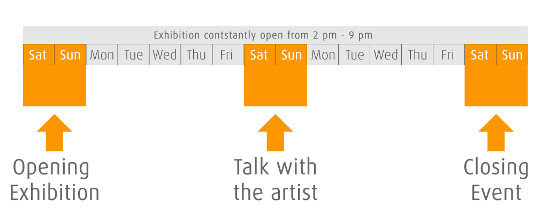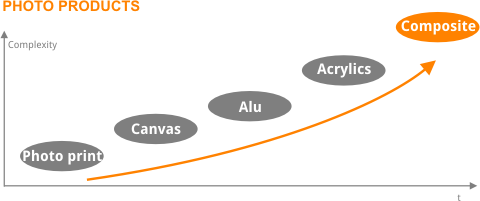Project plan as PDF:
Callback Service


Project plan as PDF:
Request free PDF now
please send the ebook via email to the following contact details:
Download for free now!
Recommend us:
Photography as a form of art is booming. Never before have so many pieces of art been sold, never before have prices for these art works been higher. As photography has finally risen attention of professional art collectors. But also a constantly growing number of semi-professional collectors is more and more interested in modern photography.
If you as a professional photographer want to organize a photo exhibition on your own you have the chance to present yourself to a very interested audience.
Those who systematically proceed and avoid mistakes right from the beginning have good chances to enthuse lovers of art and to sell their own art work. Use these tips and tricks for your photo exhibition and enter the fascinating art market of modern photography:
In general the idea of realizing a photo exhibition starts with the ambition to show your great photos to a broader audience. But in order to successfully perform a photo exhibition you have to make fundamental decisions. As only after that you can specifically design and promote your exhibition.
What aims do you want to achieve?
Depending on the aim there are different ways of approach. So there a different forms of photo exhibitions.
Especially when planning your very first photo exhibition it is of course easier to realize that together with another photographer. But don’t underestimate the need of agreements. The advantage of a co-organised photography exhibition is not only the ability to distribute tasks, but perhaps more importantly the ability to motivate each other. In any large project like organising a photography exhibition there comes a point where you just want to give up. That’s when it’s great to have a photographer on your side, to constantly keep your motivation levels up.
The location has quite a lot of influence on the success of your photo exhibition. Will you manage to get your target group go there? Is the location representing your requirements? And then the location has to fulfill very simple requirements such as:
If you plan to conduct your exhibition on a professional location such as culture institutions, galleries or museums you can reduce the amount of organization. As this locations offer for most part an already existing infrastructure and longtime experience.
Download your free exhibition planner right now
Depending on your aims you have different target groups. Generally you will get in touch with various target groups as this is very important.
Our recommendation: Inform the press about your photo exhibition on time. If your favorite media platforms are supposed to report about your exhibition you will need a press kit with all the required info. This will facilitate a coordinated professional PR and will considerably contribute to the success of your photo exhibition.
Only when you’re absolutely sure about you preferred target group you can start your specific approach. If you plan to approach “all” of them regarding your exhibition you will in the end reach none of them with your communication as nobody feels spoken to. Have a closer look on these target groups:
Further target groups can be:
Other artist and art critics, politicians, sponsors, art prospects and many more …
There is no real answer to the question of when is the right time to hold your photo exhibition. But you can avoid making some simple mistakes. While some may try to dissuade you from putting on an exhibition before the summer months others take a contrary point of view: because much fewer viewings can take place in the middle of summer, much more interest will be paid to your own photo exhibition.
Among the many arguments for and against a particular time frame, there are some undeniable facts: traditionally, people spend more money in the 4th quarter of the year. Not only are large expenses planned for this time of year, but many high earners have additional resources available such as Christmas money, a 13th or 14th month’s salary or bonus. Therefore, people believe they can afford to spend more now rather than during the rest of the year. It is even a special time of year for private companies and public institutions: they distribute even more money right before the end of the year.
Another piece of advice concerning the right time for your photo exhibition is to hook up with another event. Get involved in similar large events and take advantage of them in several ways:
All these dates can be researched long in advance by consulting an events calendar, all of which will help you avoid choosing the wrong date for your exhibition.
Further information regarding the start of your exhibition: The usual days for a viewing are Friday between 7pm and 9pm, Saturday between 3pm and 7pm, Sunday morning around 11am.
The concept for a photo exhibition can be different. The event can take place on one single night but also for a longer period. If you decide on a longer period you should keep the interest of prospective visitors on a constantly high level by planning additional events.

The displayed time schedule is only one possibility to plan your photo exhibition. Basically the concept can vary between a single evening event and one year.
Download your free exhibition planner now
Public art funding has numerous instruments to support your exhibition. It’s important that you contact the responsible bodies. On each administrative level you will find institutions that provide subsidies. This way you are not acting as a supplicant but have the right to get budgeted subsidies:
Here you can apply for subsidies:
European Union: EU Culture Fund – Cultural Contact Point in the UK / London
Great Britain: Arts Council England – National body for the arts
Region: Regional development agency
City/County: Councils – Culture department (Local authorities)
Your advantage: Applying for subsidies is easy. Many institutions provide online applications on their website. But keep in mind that the institutions’ responsibility is due to the subsidiarity principle. Meaning a superior institution is only allowed to provide fundings if an inferior body is not responsible. So start your application for art funding on local level.
Fundings are an important instrument for financing photo exhibitions. But keep in mind that the application procedure may need considerable lead time and the final decision on your application will be uncertain for some time. If you have the possibility to work with sponsors and to reduce the focus of decreasing costs this can be an advisable alternative depending on your personal aims.
Calculate your costs with our exhibition calculator
Art sponsorship has enormously increased within the past years. Especially companies like banks or insurances love to profit from the sparkling art in order to present themselves as committed with the goal to attract wealthy customers. Just ask those companies and give them the chance to participate in your project.
Approaches to marketing an exhibition or private viewing are certainly changing. While traditional media lose influence, the Internet and, most of all, social networks are becoming increasingly significant. This has the positive effect that communication is becoming cheaper as many of the costs can be covered by self-financing if you have a little experience in the matter..
Photography as a form of art won’t be sold with simple photo prints. The era of a classic photo print with passepartout and frame has come to an end. Today the photos are directly combined with their carrier material as this will satisfy the vision of the target group of photo enthusiasts in terms of art work.
This is why we at the XXLPIX photo lab offer customers who are planning a photography exhibition extensive and cost-free support. This starts with a free planning phase for the organisation of the exhibition, and continues with intensive production assistance to help choose the very best photo products such as Alu-Dibond, canvas, premium composite or acrylic glass. Our professional photo lab in Berlin also helps with choosing the right delivery to receive your goods on time and a professional mounting solution that’s right for you.
Canvas has already been a quite popular carrier for photo exhibitions for several years. The design of the wooden frame will give the canvas print an additional 3-dimensional effect. Thus photography will become a 3-dimensional piece of art.
Alu-Dibond is an exclusive inherently stable material providing cool rational aesthetics which focuses on the pictographic design of the art work. It’s very popular for technical and architectural motifs.
Acrylic glass - Printing photography on acrylic glass is the trendiest form of reproduction. By its brilliant and glossy surface the art work of the photo exhibition will be associated with modernity and premium quality.
Composite products - One of the newest technologies for producing photography are composite products. Especially the combination of an alu-dibond as carrier for a photo print which will be covered with acrylic glass is very popular. This form of photo production will for most part be used in the premium sector of photography.

The price difference between the various reproduction forms is not as high as you might think. The costs for the reproduction on acrylic glass are only 20 % higher than on canvas. It is important that you have to plan enough lead time for your project. If you want to sell your photos to art collectors and gamblers you should produce your pictures with professional high quality. In general you have to decide which carrier suits you best.
Planning means everything. Especially when planning your very first photo exhibition it might happen that you get lost in the amount of tasks. Think about applying for fundings. As this could delay your execution tremendously and the acceptance for the fundings remains unclear for a certain period of time. Many projects have already been canceled due to the complexity of subsidiary applications. Note: you have to tactically plan your exhibition for which this schedule will support you in doing so.